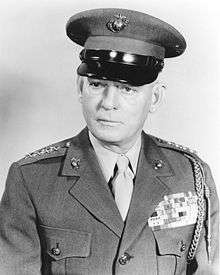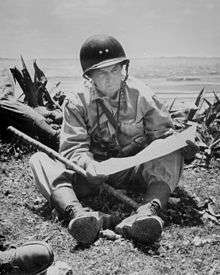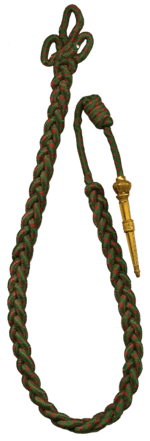Lemuel C. Shepherd Jr.
| Lemuel C. Shepherd Jr. | |
|---|---|
 20th Commandant of the Marine Corps (1952-1955) | |
| Birth name | Lemuel Cornick Shepherd Jr. |
| Born |
February 10, 1896 Norfolk, Virginia, U.S. |
| Died |
August 6, 1990 (aged 94) La Jolla, California, U.S. |
| Buried at | Arlington National Cemetery |
| Allegiance |
|
| Service/branch |
|
| Years of service | 1917–1956 |
| Rank |
|
| Commands held |
Commandant of the Marine Corps Assistant Commandant of the Marine Corps Marine Corps Schools 6th Marine Division 1st Provisional Marine Brigade 9th Marine Regiment 2nd Battalion, 5th Marines |
| Battles/wars | |
| Awards |
Navy Cross Distinguished Service Cross Navy Distinguished Service Medal (3) Silver Star (3) Legion of Merit (2) w/ Combat "V" Bronze Star Medal w/ Combat "V" Purple Heart (4) French Croix de guerre French Fourragère |
| Other work | Inter American Defense Board, Chair[1] |
Lemuel Cornick Shepherd Jr. (February 10, 1896 – August 6, 1990) was a four-star general of the United States Marine Corps. A veteran of World War I, World War II, and the Korean War, he was the 20th Commandant of the Marine Corps. As Commandant, he secured a place on the Joint Chiefs of Staff, gaining parity for the Marine Corps with the other military services.[2]
Early life and education
Lemuel Cornick Shepherd Jr. was born February 10, 1896, in Norfolk, Virginia. He graduated from the Virginia Military Institute in 1917,[1] graduating a year early so he could enter the Marine Corps.[3] While at VMI, Shepherd became a member of the Beta Chapter of Kappa Alpha Order. He was commissioned a second lieutenant in the Marine Corps on April 11, 1917 and reported for active duty at the Marine Barracks, Port Royal, South Carolina, on May 19, 1917.
World War I
Less than a year after reporting for duty, 2nd Lt. Shepherd sailed for France on June 17, 1917 as a member of the 5th Marine Regiment with the first elements of the American Expeditionary Forces (Army and Marine Corps troops), and arrived at Saint-Nazaire in western France on June 27. The 5th Marines became part of the 4th Marine Brigade,[4] 2nd Division (2nd Infantry Division), when the division was organized on October 26 in France.[5] The 2nd Division was placed under the command of Marine Corps Brigadier General Charles A. Doyen, who had been the 5th Marines commander. The 2nd Division trained with French Army veterans the winter of 1917-18.
Shepherd served in defensive sectors in the vicinity of Verdun. When the American Expeditionary Forces (AEF) was committed to combat in the spring of 1918 to halt a German advance towards Paris,[6] he participated in the Aisne-Marne offensive (Château-Thierry) where he was twice wounded in action at Belleau Wood during the fighting there in June 1918. On July 28, 1918, Marine Corps Major General John A. Lejeune (Marine Corps Base Camp Lejeune, named 1942) assumed command of the 2nd Division. He returned to the front in August, rejoining the 5th Marines, and saw action in the St. Mihiel and Meuse-Argonne offensives (Champagne) where he was wounded for the third time, shot through the neck by a machine gun.
For his gallantry in action at Belleau Wood, Lieutenant Shepherd was awarded the Army Distinguished Service Cross and the Navy Cross, the French Croix de guerre, and was cited twice in the general orders of the 2nd Infantry Division, American Expeditionary Forces.[7][8][9] He also received the Montenegrin Silver Medal for Bravery.[10]
After duty with the Army of Occupation in Germany, Captain Shepherd sailed for home in July 1919. In September 1919, he returned to France. His assignment was to prepare relief maps showing the battlefields over which the 4th Marine Brigade (5th and 6th Marines and 6th Machine Gun Battalion),[11] 2nd Infantry Division, had fought.
Between the wars
Shepherd returned to the States in December 1920, and was assigned as White House aide and Aide-de-Camp to the Commandant of the Marine Corps, Major General John A. Lejeune.
In July 1922, he took command of a selected company of Marines at the Brazil's Centennial Exposition in Rio de Janeiro.[12]
In June 1923, Shepherd was ordered to sea duty as Commanding Officer of the Marine Detachment on the USS Idaho (BB-42). This tour was followed by duty at the Marine Barracks, Norfolk, where he commanded the Sea School. In April 1927, Shepherd sailed for expeditionary duty in China, where he served in the 3rd Marine Brigade in Tientsin and Shanghai.
Shepherd returned to the United States in 1929 and attended the Field Officers' Course, Marine Corps Schools. After graduation Captain Shepherd was assigned overseas again, this time on detached duty with the Garde d'Haïti, serving for four years as a District and Department Commander in the United States occupation of Haiti. Following the withdrawal of Marines from Haiti in 1934, Major Shepherd was detailed to the Marine Barracks, Washington, D.C., as Executive Officer and as Registrar of the Marine Corps Institute.[13]
Following graduation in May 1937 from the Naval War College at Newport, Rhode Island, he commanded the 2nd Battalion, 5th Marine Regiment, part of the newly formed Fleet Marine Force (FMF), Atlantic, which was being extensively employed in the development of amphibious tactics and techniques.
In June 1939, he was ordered to the Staff of Marine Corps Schools, Quantico, Virginia, where he served during the next three years as Director, Correspondence School; Chief of the Tactical Section; Officer in Charge of the Candidates Class; and Assistant Commandant.
World War II



In March 1942, four months after the United States entry into World War II, Colonel Shepherd took command of the 9th Marine Regiment. He organized, trained, and took the unit overseas as part of the 3rd Marine Division.
Upon promotion to Brigadier general in July 1943, he served on Guadalcanal. Brigadier General Shepherd was assigned as Assistant Division Commander of the 1st Marine Division. In this capacity, he participated in the Cape Gloucester operation on New Britain from December 1943 through March 1944, where he was awarded a Legion of Merit for exceptionally meritorious service[8] in command of operations in the Borgen Bay area.
In May 1944, Shepherd assumed command of the 1st Provisional Marine Brigade and led them in the invasion and subsequent recapture of Guam during July and August 1944. For distinguished leadership in this operation, Shepherd received his first Distinguished Service Medal[8] and was promoted to Major General.
After organizing the 6th Marine Division from the Brigade, Shepherd commanded it throughout the Battle of Okinawa where, for exceptionally meritorious service as Commanding General of the 6th Marine Division in the assault and occupation of Okinawa (April 1 to June 21, 1945) he was awarded a Gold Star in lieu of a second Distinguished Service Medal.[8] Subsequently he took the Division to Tsingtao, China. There, October 25, 1945, he received the surrender of the Japanese forces in this area for which he was awarded a second Legion of Merit.[8]
1946–1956
Several months later, Shepherd returned to the United States and in March 1946, organized the Troop Training Command, Amphibious Forces, Atlantic Fleet, at NAB Little Creek, Virginia. On November 1 of the same year, he was ordered to duty as Assistant to the Commandant Marine Corps Headquarters. He remained at this post until April 1948, when he was assigned to Quantico where he served as Commandant of the Marine Corps Schools until June 1950.
When the Korean War erupted, Shepherd was in command of the Fleet Marine Force (FMF), Pacific, with headquarters at Pearl Harbor. In this capacity, he played a major role in the amphibious assault at Inchon, earning a Silver Star,[8] and in the evacuation of U.S. forces from Hungnam following their withdrawal from the Chosin Reservoir in North Korea in December 1950. In Korea he saw the usefulness and advantages of Helicopters on the frontlines and was amongst those pushing for the increase in number of helicopters in the armed forces saying "No effort should be spared to get helicopters ... to the theater at once - and on a priority higher than any other weapon."[14]
On January 1, 1952, President Harry S. Truman appointed Shepherd Commandant of the Marine Corps (CMC). During Shepherd's four years as Commandant, he initiated a number of important policies that resulted in increased military proficiency for the Marine Corps, one of the first and widest reaching of which was the institution of a General Staff System. Shepherd presented the Marine Corps War Memorial to the American people at the dedication of the memorial on November 10, 1954, the 179th anniversary of the founding of the Marine Corps.[15][16] He was the first Commandant to become a member of the Joint Chiefs of Staff, and upon his retirement on January 1, 1956, he was awarded a third Distinguished Service Medal.[8]
1956–1990
Two months after his retirement, Shepherd was recalled to active duty and appointed Chairman of the Inter-American Defense Board. During his three and a half years of service with this international organization, Shepherd, through his leadership and diplomacy, made substantial contributions towards plans for the defense of the continent. He also promoted military solidarity among the military forces of the republics of the Western Hemisphere. He relinquished his duties with the Inter-American Defense Board on September 15, 1959.
Shepherd died at age 94 from bone cancer at his home in La Jolla, California.[3] He was buried with full military honors at Arlington National Cemetery.[17]
Awards and decorations
Shepherd's military awards include:[8][18][19]
 | ||||
Other awards and recognitions:
- Bronze plaque with Diploma Commemorative Especial (Brazil)
- Commendatory letter from the Joint Chiefs of Staff (dated 15 Sept. 1959).
- Marine Corps Historical Foundation's Distinguished Service Award "for numerous and substantial contributions to the history of the Marine Corps that span more than seventy years."
See also
References
![]() This article incorporates public domain material from websites or documents of the United States Marine Corps.
This article incorporates public domain material from websites or documents of the United States Marine Corps.
| Wikimedia Commons has media related to Lemuel C. Shepherd Jr.. |
- 1 2 "'Letters, Diaries, Manuscripts. Military History' (see Lemuel C. Shepherd Jr. Papers)". VMI Archives. VMI. Retrieved 2008-01-11.
- ↑ Marine Corps League. "Fighting for the Corps", Semper Fi, March/April 2010, 75-76.
- 1 2 Fowler, Glenn (August 8, 1990). "Lemuel Shepherd Jr., 94, Ex-Chief Of Marines Who Served in Three Wars". The New York Times. Retrieved November 1, 2008.
- ↑ 4th Marine Brigade
- ↑
- ↑
- ↑ Bruce, Philip Alexander; Stanard, William Glover, eds. (1919). "The Virginia Magazine of History and Biography". 27. Virginia Historical Society: 359.
- 1 2 3 4 5 6 7 8 "Valor awards for Lemuel Cornick Shepherd Jr.", Hall of Valor, Military Times, retrieved Apr 21, 2014
- ↑ United States War Dept. (1919). General Order 101. General Orders 1918: U.S. Government Printing Office. p. 39. Retrieved Apr 21, 2014.
- 1 2 Virginians of Distinguished Service of the World War. 1. Virginia War History Commission. 1923. p. 199.
- ↑ 4th Marine Brigade
- ↑ "50 Facts about the Marine Corps: #46". Cougar Scream. USS Washington newsletter. 1 (XXIII). November 8, 1941. Retrieved November 2, 2008.
In August 1922, a detachment of U. S. Marines was assigned to duty at the Brazilian Centennial Exposition, held at Rio de Janeiro, as an evidence of the cordial relations existing between the Brazilian and American Governments.
- ↑ "Gen. Shepherd's Record of Hard Fighting, High Awards" (PDF). The 'VMI' Cadet. XLX (9). Lexington, Virginia: Virginia Military Institute. Nov 20, 1959. p. 3. Retrieved Apr 21, 2014.
- ↑ Cited in B.Gen. Clayton C. Jerome's memo to ViceAdm Cassady, RAdms Soucek, Duckworth, Pride, and Goe, of 19 Sep. 1950, available on page 187 here
- ↑ "Marine monument seen as symbol of hopes, dreams". Spokane Daily Chronicle. Washington. Associated Press. November 10, 1954. p. 2.
- ↑ "Memorial honoring Marines dedicated". Reading Eagle. Pennsylvania. Associated Press. November 10, 1954. p. 1.
- ↑ "Lemuel Cornick Shepherd Jr., General, United States Marine Corps". ArlingtonCemetery.net. December 17, 2005. Retrieved 2008-01-11.
- ↑ Block, Maxine; Rothe, Anna Herthe; Candee, Marqorie Dent (1953). Current Biography Yearbook, Who's news and why 1952. H.W. Wilson Co. p. 539.
- ↑ "General Lemuel C. Shepherd Jr., USMC". Who's Who in Marine Corps History. History Division, United States Marine Corps. Retrieved 2016-08-08.
- ↑ "Crnogorsko - Americka Odlikovanja" [Montenegro - U.S. Orders]. Montenegro-Canada: Crnogorski website U americi (in Montenegrin). Retrieved Apr 21, 2014.
- ↑ The Monthly Supplement: a current biographical reference service. 7–8. A.N. Marquis company. 1946. p. 67.
- ↑ Meid, Pat, Lieutenant Colonel, USMCR; Yingling, James M., Major, USMC (1972). U.S. Marine Operations in Korea 1950-1953 (PDF). V Operations in West Korea. Washington, D.C.: Historical Division, Headquarters, U.S. Marine Corps. p. 159.
- 1 2 3 United States Congress (Aug 27, 1958), Private Law 85-704 (S.3195) (PDF), U.S. Government Printing Office, retrieved Apr 21, 2014
- Web
- "General Lemuel C. Shepherd Jr., USMC". Who's Who in Marine Corps History. United States Marine Corps History Division. Archived from the original on Feb 21, 2007. Retrieved 2007-11-03.
- "Lemuel Cornick Shepherd Jr., General, United States Marine Corps". Arlington National Cemetery. December 17, 2005. Retrieved 2008-01-11.
- Periodicals
- Fowler, Glenn (August 8, 1990). "Lemuel Shepherd Jr., 94, Ex-Chief Of Marines Who Served in 3 Wars". The New York Times. Retrieved 2008-01-11.
- Simmons, Edwin H., BGen, USMC (Ret.) (Fall 1990). "Remembering General Shepherd" (PDF). Fortitudine. The Marine Corps Historical Program. XX (2): 3–11.
- Sarokin, Paul (January 1956). "Return to Belleau Wood". Leatherneck Magazine. Archived from the original on Mar 23, 2012. Retrieved November 3, 2008. Includes transcript of General Shepherd's speech on November 18, 1955 at Belleau Wood for the unveiling of a statue dedicated memory of the 4000 Marines who died at Belleau Wood.
- Books
- Alexander, Colonel Joseph H., USMC (Ret) (1995). The Final Campaign: Marines in the Victory on Okinawa. Marines in World War II Commemorative Series. Washington, D.C.: History and Museums Division, United States Marine Corps. Retrieved 2007-11-03.
- Burrell, Robert S. (2006). The Ghosts of Iwo Jima. Texas A&M University Press. ISBN 1585444839. Retrieved 2008-11-02. Includes discussion of Lemuel's efforts to raise funds for an Iwo Jima memorial and his place on the Joint Chiefs of Staff.
- Allan Reed Millett and Jack Shulimson, eds. (2004). Commandants of the Marine Corps. Annapolis, Maryland: Naval Institute Press. pp. 328–348. ISBN 978-0-87021-012-9.
External links
- U.S. Marine Corps, History Division - General Lemuel C. Shepherd Jr.
- Arlington Cemetery - General Lemuel C. Shepherd Jr.
- Lemuel C. Shepherd Jr. at Find a Grave
| Military offices | ||
|---|---|---|
| Preceded by Gen. Clifton B. Cates |
Commandant of the United States Marine Corps 1952–1955 |
Succeeded by Gen. Randolph M. Pate |
